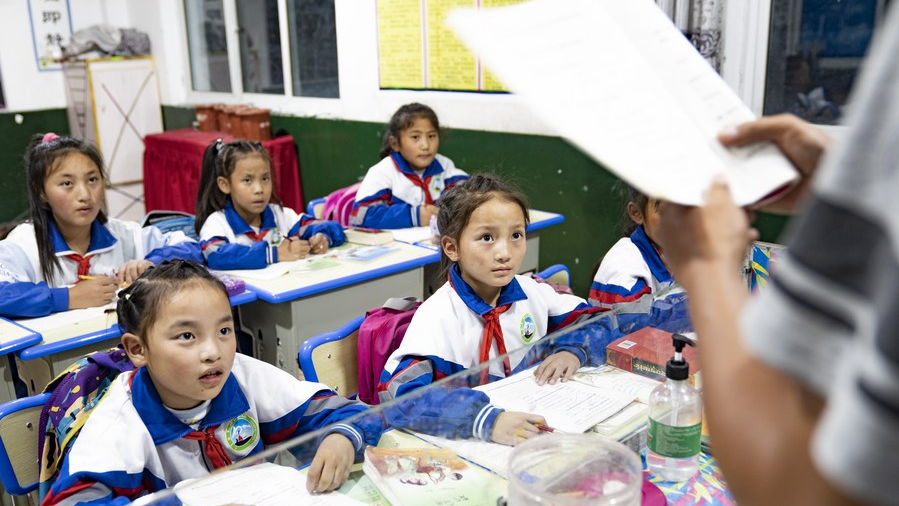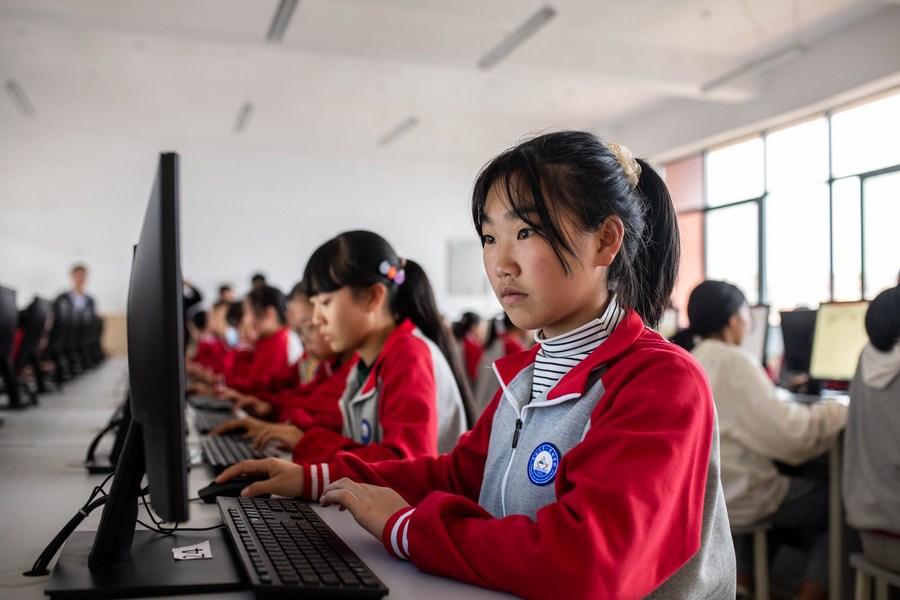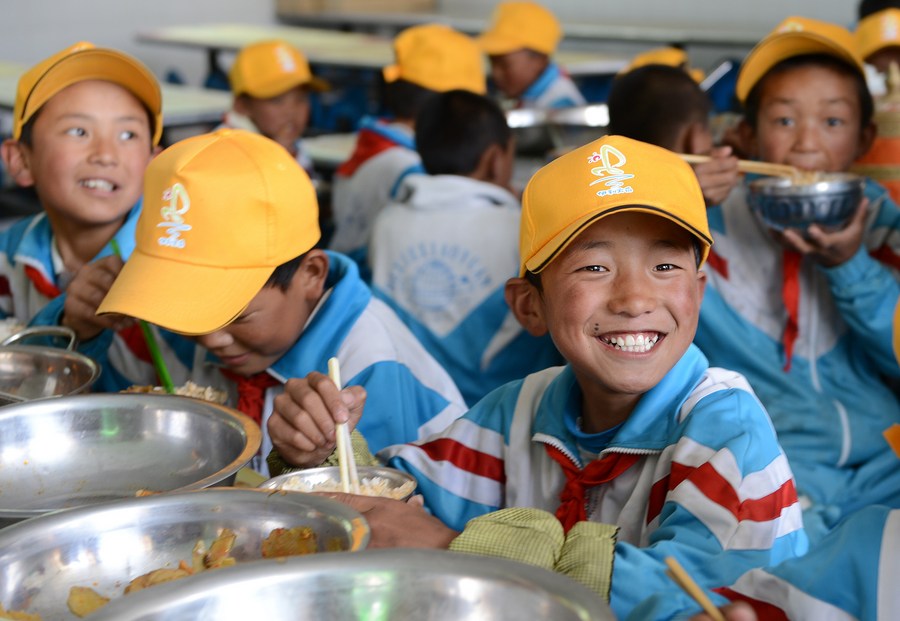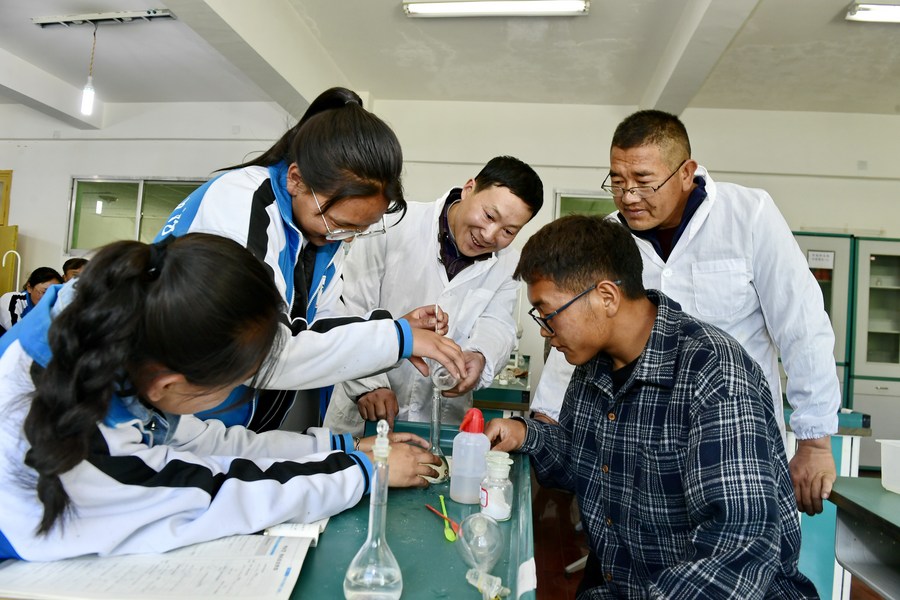
A class in Dobbar Township of Zongang County in Qamdo City, southwest China's Tibet Autonomous Region, September 14, 2020. /Xinhua
A class in Dobbar Township of Zongang County in Qamdo City, southwest China's Tibet Autonomous Region, September 14, 2020. /Xinhua
China has overcome difficulties to forge ahead in 2020 and achieved a decisive victory in poverty alleviation, said President Xi Jinping in his New Year address on Thursday. Upon this historic milestone in building a moderately prosperous society in all respects, education has played a fundamental role.
President Xi has always prioritized education, especially in poor rural regions, to eliminate poverty from the roots. In the 13th Five-Year Plan period (2016-2020), around 749.5 billion yuan ($114.6 billion) was allocated from the central budget, and 90 percent of the funds have been invested in rural areas, according to the Ministry of Education (MOE).
And for years, various measures have been taken to ensure the quality of education, producing fruitful results in 2020.

A computer class at a school in a poverty-relief resettlement site in Zhenxiong County, Zhaotong City, southwest China's Yunnan Province, September 24, 2020. /Xinhua
A computer class at a school in a poverty-relief resettlement site in Zhenxiong County, Zhaotong City, southwest China's Yunnan Province, September 24, 2020. /Xinhua
Dropouts decline sharply
There are many reasons why children drop out of school, including inconvenient transport arrangements, work at a young age, early marriage and early childbirth, and physical disabilities.
To realize the goal of "not leaving behind any student" during the nine-year compulsory education period, local governments have created their own solutions according to their own situation.
In northwest China's Shaanxi Province, from county heads to directors of education bureaus, from principals to parents, people in positions of responsibility have been involved in the system to identify students and ensure they are registered in schools. And in Guangxin District of Shangrao, east China's Jiangxi Province, parents of some drop-out students were sued in accordance with the law to help their children return to school.
The number of students dropping out of school before completing nine years of compulsory education in China fell to 831 at the end of November 2020, down from around 600,000 in early 2019, according to the MOE.

File photo of Wanquan Primary School students having their lunch at school in Pozhang Township, Shannan, southwest China's Tibet Autonomous Region. /Xinhua
File photo of Wanquan Primary School students having their lunch at school in Pozhang Township, Shannan, southwest China's Tibet Autonomous Region. /Xinhua
Subsidies aid children in need
For students who experience financial difficulties, subsidies are in place to help them. China not only exempts students nationwide during the compulsory education period from tuition and miscellaneous fees and gives them free textbooks, but also provides a living allowance to students from poor families.
Data from the MOE show that from 2016 to 2020, the central government has allocated a total of 393.12 billion yuan in public subsidies to support compulsory education, 43.59 billion yuan in living allowances to support students from families with financial difficulties and 71.21 billion yuan subsidies in free textbook.
In southwest China's Tibet Autonomous Region, a preferential educational subsidy policy was carried out. It benefits children from farming, pastoral and underprivileged backgrounds by covering all their tuition fees, food and board from pre-school to senior high school. Every student could receive an average annual subsidy of 4,200 yuan.
"We now get milk in between lessons," Deqen Wangmo, a student at Lhasa No.8 Middle School, told Xinhua News Agency, "and the school also provides us with stationery, which means our families don't have to buy these items."

Cai Chunting (C), a teacher from Xiangyang, central China's Hubei Province, and Cering Choden (back R), a local teacher, in a chemical experiment in Shannan No. 1 Senior High School, southwest China's Tibet Autonomous Region, May 7, 2019. /Xinhua
Cai Chunting (C), a teacher from Xiangyang, central China's Hubei Province, and Cering Choden (back R), a local teacher, in a chemical experiment in Shannan No. 1 Senior High School, southwest China's Tibet Autonomous Region, May 7, 2019. /Xinhua
Quality of education improved
Unequal access to education and disparate distribution of academic resources has impeded the improvement of China's overall quality of education.
To improve the quality of education in the country's poor rural areas, an annual government program has been implemented to recruit and assign teachers to rural schools for the past 15 years.
From 2006 to 2020, the central government has invested a total of 71 billion yuan to recruit and assign 950,000 teachers, covering more than 1,000 counties and more than 30,000 rural schools in the central and western provinces, according to the MOE.
In the academic year between 2020 and 2021 alone, China will dispatch more than 22,000 teachers to the country's poverty-stricken regions to work for one year.

